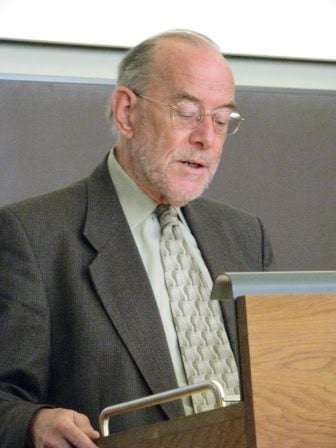 Dr. James D. G. Dunn is one of the foremost New Testament scholars in the world. And he is a friend of mine. I love Jimmy Dunn. I have learned so much from the times I’ve been with him, but especially from his voluminous writings. Jimmy is such a careful scholar. He is now retired but still writing. He is an Englishman, a Methodist, and a moderate evangelical.
Dr. James D. G. Dunn is one of the foremost New Testament scholars in the world. And he is a friend of mine. I love Jimmy Dunn. I have learned so much from the times I’ve been with him, but especially from his voluminous writings. Jimmy is such a careful scholar. He is now retired but still writing. He is an Englishman, a Methodist, and a moderate evangelical.
Dr. Dunn has a new book out entitled Jesus According to the New Testament (Eerdmans, Jan. 2019). I am looking forward to reading it.
The two biggest differences in Jesus’ teaching between the synoptic gospels (Matthew, Mark, and Luke) and the Gospel of John are (1) the synoptics mostly present Jesus teaching parables while John has no such parables, and (2) John has Jesus saying several “I am” (Greek ego eimi) statements about his identity whereas the synoptics have none of them. These differences have perplexed Christians and their scholars.
I notice in Jimmy’s new book that he briefly addresses these two differences. He quotes most of Jesus’ “I am” sayings having a predicate in the Gospel of John (Jn 6.35; 8.12, 58; 10.11; 11.25; 14.6; 15.1), I think leaving out only Jn 10.7, 9, “I am the gate/door.” Jimmy then says of the Gospel of John (pp. 54-55), “It is a striking fact that these ‘I am’ sayings appear only in the Fourth Gospel. It is almost impossible to believe that there were such sayings in the Jesus tradition, sayings that Jesus was remembered as uttering about himself, and yet all three synoptic evangelists ignored them completely. Much the more obvious explanation is that they were sayings attributed to Jesus by John not because he was remembered as uttering them, but because they brought out the significance of Jesus and his ministry like nothing else in the Jesus tradition.”
So, Dunn suggests that Jesus didn’t actually say any of the “I am” sayings with predicates in the Gospel of John because none of them are recorded in any of the synoptics, nor do they have any similar self-identification sayings of Jesus.
I can’t accept this. I think the main reason the Gospel of John presents a different picture of Jesus than that in the synoptic gospels is that Jesus’ ministry reported in the synoptics is primarily in Galilee, and some in Perea, whereas nearly all of the material about Jesus in the Gospel of John has him attending the feasts at Jerusalem. Thus, in the Galilean ministry portrayed in the synoptics, Jesus addresses common folk; but in Jesus’ Johannine sayings uttered mostly at the feasts at Jerusalem, and often at the temple, Jesus sometimes encountered religious authorities. Yet most of those sayings were delivered privately to his disciples. Thus, John reports a different segment of Jesus’ ministry than the synoptics do. Plus, all of John 12–20 is about Passion Week, which was at Jerusalem.
This question–about this difference of Jesus “I am” sayings with a predicate in John and nothing like it in the synoptics–relates to how we got the New Testament gospels. The synoptics record mostly meticulous oral tradition handed down by church communities that eventually was written. Ancients mostly were illiterate. Historians claims that in the Mediterranean world during the first century, only about 5% of the people were literate, and these were mostly the elite and politicians. It is possible that Jews in Israel had a higher literacy rate, due to being taught the Torah. But most scholars claim it wouldn’t have been more than 10-15%. I think Craig Evans is one of the few who thinks it was that high or higher. Nevertheless, most people were illiterate.
Thus, oral tradition was of the utmost importance to most people, not written tradition since they could not read or write. Even when Christians gathered together as a congregation on Sundays in the first century, they got their teaching by listening, not by reading. Therefore, the synoptic gospels came into existence as mostly compilations, not authored books. Mark may have gotten most of his material from listening to Peter preaching, as Papias claims, but Matthew and Luke surely collected oral tradition from church communities and perhaps some writings containing oral tradition (cf. Lk 1.1-4).
But that is not how the Gospel of John came into existence. It seems to be mostly the recollections of “the beloved disciple.” Later church tradition identified him as the Apostle John and that he wrote the gospel that is named after him. But the Fourth Gospel is more likely the remembrance of John (yes, I think he probably was the beloved disciple) that was written down by others.
So, I think the answer to why the difference between John and the synoptics is this: different time, different place. And because of it, Jesus spoke mostly to different people and thus he ministered accordingly. In the Galilean and Perean ministry, he revealed his wisdom in teaching to crowds, and he demonstrated the power of God in him to heal others. But at Jerusalem, being often before the religious authorities, Jesus said a lot about his identity, however obscurely.
So, I don’t like to disagree with my favorite Bible teacher, Jimmy Dunn, but I think Jesus did utter the “I am” sayings with predicates that are attributed to him in the Gospel of John.
















